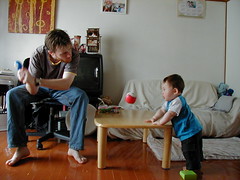My Reflection on Last Week's Lesson
Please choose a response to the sentences below. Each response only has one answer:
1. Does he know? a. I’ve told him twice.
2. Why are you annoyed? b. I have told him twice.
3. Shall we go? c. That's David Bowie.
4. Why aren’t you ready yet? d. That is David Bowie.
5. Who’s that? e. I am ready.
6. Is David Bowie here? f. Yes, I'm ready.
The answers (I believe) are1. a 2. b 3. f 4.e 5. c 6. d
(Take from Lewis, M & J. Hill. (1992). Practical Techniques for Language Teaching. England: Language Teaching Publications.
I think the reason why this activity did not go well was in the spontaneous decisions that I made. The purpose of this exercise was to show you that grammar (language) learning can be fun when students are allowed to explore what the answers are for themselves. This activity did not go as smoothly as I would have liked because when it seemed that you were struggling I intervened and did not allow you to explore. Rather, I called on individuals to answer the questions.
To make the exercise fun and interesting this is what I should have done:
I should have given you more time to explore and I should have asked you to work on this in groups. I also should have asked you to say why you believed your answer to be so and to give an example of a situation where you would answer in such a way. For 1 and 2 as well as 5 and 6 I believe that the answers can change depending on what kind of situation the untterance is spoken in.
Since we did not have much time and I had a lot of activities to introduce to you, I hurried through the above activity. In retrospect, I should not have hurried through it.
One more problem, I was tired and became confused myself as to what the correct answers were for 5 and 6. After a good night's sleep, the answers to 5 and 6 made sense. However, the answers can change depending on the situation of the utterance. I realized that getting a good night's sleep is almost as important for a lesson as lesson preparation.





